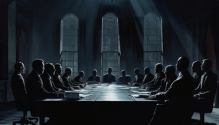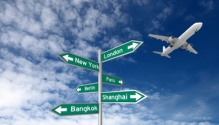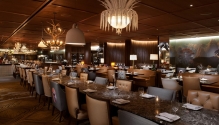Where Mumbai Meets Modern Minimalism
At Fairfield by Marriott Mumbai International Airport, the most captivating sight is of aircrafts taking flight and touching down against the fiery canvas of a Mumbai sunset. Step within and discover a design-driven oasis that reimagines what a mid-market business hotel can be like.
By Deepali Nandwani
The view from the 9th-floor Presidential Suite of Fairfield by Marriott International Airport is a spectacle of modern aviation. The runway stretches into the distance, a grey ribbon against the backdrop of the sky, with its markings and lights visible. And the sky is blazing orange fast turning into flaming red as the sun sets. Every few seconds, flights taxi in, slide into their hangar, and another flight takes off.
If your view from a hotel room doesn’t include the sea off the Marine Drive/Bandra/Worli coastline or the vertiginous towers of Lower Parel (if you enjoy the quintessential urban vista), this could be the best view you can ask for. As the night shrouds the city, the darkness is pierced by the taillights of the flights landing and taking off and the dim tarmac lights. Glance a little to the left and you see kids playing football on an elevated pitch, a stark reminder of the lack of open spaces in Mumbai.
The rooftop, a unique feature for a Fairfield property, offers panoramic views of the airport runway. On one end is an infinity pool from where the skyline is a blend of blue on a good weather day, the tarmac lights, flights landing and taxing, and buildings in the distance. General Manager Iftekhar Mehdi tells me the hotel hosts sundowners at the rooftop level “which have been rather popular”.
Ajoy Balkrishna, Vice President, Balwa Group, which owns this premium business property in the heart of suburban Mumbai, says over a languid breakfast in its sun-suffused all-day dining, Mado Mado, “Our guests largely include business travellers, but on weekends, they can also include aviation geeks who check-in for an opportunity to watch flights landing and taking off, to try and identify the aircraft and photograph them.”
Fairfield by Marriott Mumbai International Airport is not another cookie-cutter hotel. Opened in 2022 after navigating the challenges of the pandemic, this property has quickly become a design exemplar for the Fairfield brand and other business hotels in the mid-market segment. Strategically positioned near Mumbai's bustling international airport, it caters to the modern business traveller with a focus on efficiency and comfort, all while offering a sophisticated and stylish experience.
This success story is a testament to the vision of the hotel's owners, Hussein Balwa, Chairman, and Rafiq Balwa, Executive Director & Vice President of the Balwa Group, who sought to create a property that transcended the Fairfield template. They envisioned a hotel with a distinct identity, one that could stand out amongst the growing number of hotels in the area and compete with nearby luxury giants such as the JW Marriott in the neighbourhood. To achieve this, they partnered with Khozema Chitalwala of Designers Group, who brought his expertise to translate this vision into a reality.
Rafiq Balwa contends, “There was no mid-market business hotel near the International Airport and I think we have been able to maximise the revenue potential by maximising the capacity. A 20sq.mtr. room at Fairfield fetches me around ₹8,000 to ₹9,000 per night, whereas a 40 sq.mtr. room at JW Marriott Mumbai Sahar is fetching them around ₹12,000. If I were to take a combination of my two rooms, which amounts to 40 sq.mtr., it fetches me around ₹22,000 per night, whereas JW Marriott earns around ₹12,000 for the same size.”
The design concept, particularly for the public areas, has evolved over many conversations between the Balwas and Chitalwala. “A blend of standardised rooms (except the suites) and customised public areas creates a distinctive experience for guests,” says Balwa.

The façade plays with various patterns and textures to elevate the hotel's experience. To capture the nautical spirit of the city, the colour scheme ranges from white to blue.
A design narrative rooted in Mumbai
While adhering to Marriott’s minimalist brand philosophy, Chitalwala weaved in a narrative inspired by the "lifelines of Mumbai"—the iconic elements that keep the city pulsating with life. This is reflected in the artwork, which draws inspiration from Mumbai's Indo-Saracenic and Indo-Gothic architecture, and graphic representations of the now rapidly disappearing black-and-white taxis, the sprawling network of local trains, and the famous dabbawalas, who navigate the city's labyrinthine streets to deliver hot lunches. These elements, integral to Mumbai's spirit, are woven into the hotel's design language through subtle yet impactful artistic expressions.
The art program, curated by Manjula Bhattacharya, further enriches the hotel's connection to Mumbai. Inspired by the city's rich architectural heritage, the artwork adds cultural depth to the hotel's aesthetic.
“Right from the lobby, dining areas, banqueting facilities, terrace pool area, through to the common areas and the rooms, Fairfield by Marriott Mumbai International Airport is a parametrically designed celebration of all that symbolises the city. The colour palette, the artwork, installations, furniture are all a tribute to the audacious aspirations of the city-dwellers, a documentary of untold stories spanning centuries, and an insight into the coastal tides that have shaped modern-day Mumbai. These highlight an evolved metropolis, from libraries and parks to railway stations and bridges and everything that makes up Mumbai,” says Chitalwala.

Rafiq Balwa, Executive Director & Vice President, Balwa Group
Our design has proven so successful that we frequently receive compliments from guests who prefer staying with us over other hotels in the area for the overall flow and guest experience.
Rafiq Balwa
Executive Director & Vice President, Balwa Group

Public spaces that captivate
The visual disconnect from other Fairfields begins as soon as I walk into Fairfield by Marriott Mumbai International Airport, and encounter the striking design of its public spaces. The lobby is a symphony of colours inspired by the Mumbai skyline, creating a visual connection to the city beyond the hotel walls. The lighting, reminiscent of the undulating sand dunes on Mumbai's beaches, adds a touch of whimsy and organic flow.
Burnished by sunlight, with a view of the few trees in the neighbourhood, Mado Mado, the coffee shop-meets-all-day-dining, is a vibrant space. Its long, flowing layout, bordered by expansive windows, creates a sense of openness, while a dedicated private dining area offers a more intimate setting. “Instead of sizing our coffee shop to the typical 75-80 seats for a 200-room hotel, we opted for a much larger, airier space with 136 seats,” says Balwa. “Flooded with natural light pouring through expansive windows, it's a signature element in my design approach, prioritising a bright, welcoming ambience.”

The view from the Presidential Suite is of the runway, with its markings and lights visible.
The hotel's smaller room sizes, while initially a concern, have proven to be a strategic advantage. By maximising room capacity, the hotel can offer competitive rates while still maintaining profitability.

Attention to detail
The hotel's design philosophy extends beyond the grand gestures to encompass thoughtful details that elevate the overall experience. Intricate jaali screens, referenced from the Indo-Gothic architectural style, grace the entrance and are echoed in screens and elevator doors throughout the hotel. These partitions add visual interest and subtly delineate spaces within the open plan.
“The parametric pattern resonated with the overall design language. We featured it prominently on screens in the lift lobby and pre-function areas. These screens serve as visual dividers and artistic elements, seamlessly blending with the minimalist aesthetic,” says Chitalwala.
There is a bar on the ground level, located there for easy access, so that “people could walk in, have a drink or two, and walk out easily,” reflects the designer. “Originally conceived as a boutique hotel, the building was adapted to accommodate a Marriott property. The focus on natural light, especially in the dining and coffee areas, enhances the overall experience.”

Khozema Chitalwala, Co-Founder, Designers Group
The colour palette, the artwork, installations, furniture are all a tribute to the audacious aspirations of Mumbaikars, a documentary of untold stories spanning centuries, and an insight into the coastal tides that have shaped modern-day Mumbai.
Khozema Chitalwala
Co-Founder, Designers Group

Accommodations beyond the standard
While the hotel adheres to Fairfield's standard room sizes, it offers a range of accommodations that cater to diverse needs. The Executive Suites, located on the 3rd to 7th floors, provide a more spacious option for those seeking extra comfort. And in a truly unexpected move for a Fairfield, the hotel boasts two Presidential Suites on the 9th and 10th floors, offering a luxurious experience. While one has a long dining table for those who check in with a large family and friends, the other features a bathtub.
Adds Chitalwala, “Despite the inherent limitations of the Fairfield brand and small room sizes, the owners were determined to offer a premium experience. Capitalising on the building's height restrictions near the airport, we transformed a top-floor corner, originally intended for a gym, into a luxurious suite boasting stunning airport views.”
Plans had to be reworked more than once, however. “Just before finalising the design, Rafiq and I recognised a critical flaw in the room layout: the bed orientation. To optimise the space, we made a decisive change, rotating the bed and reworking the entire layout. This required significant revisions to the drawings, but ultimately resulted in a more functional
and aesthetically pleasing room,” says Chitalwala.

The art program enriches the hotel's connection to Mumbai and adds cultural depth to the aesthetic.
The hotel's design philosophy extends beyond the grand gestures to encompass thoughtful details that elevate the overall experience. Intricate jaali screens, referenced from Indo-Gothic architectural style, grace the entrance and are echoed in screens and elevator doors throughout the hotel.

A business model built on efficiency
Sure, Fairfield by Marriott Mumbai International Airport's success can be attributed to its design, but the hotel's strategic location near the airport and its focus on catering to the needs of short-stay business travellers have also played a crucial role. It is one of the few Fairfields that welcome Marriott Bonvoy Platinum members, despite there being a JW Marriott close by, a luxury hotel from the same group.
Balwa explains that the decision to partner with Marriott was driven by the brand's strong distribution network and efficient onboarding process. The hotel's design, which emphasises functionality and streamlined flow, complements this business strategy. The hotel's smaller room sizes, while initially a concern, have proven to be a strategic advantage. By maximising room capacity, the hotel can offer competitive rates while still maintaining profitability. This approach has resonated with budget-conscious business travellers, who appreciate the value and convenience offered by the Fairfield brand.
“Catering to the short-stay business traveller—with an average stay of just over a day—we prioritised efficiency and comfort. Knowing most guests arrive late after meetings and depart early following breakfast, we focused on maximising their brief experience by providing a seamless stay,” adds Balkrishna.

The bar features vintage décor pieces and an undulating light which connects it to the lobby.
The hotel's smaller room sizes, while initially a concern, have proven to be a strategic advantage. By maximising room capacity, the hotel can offer competitive rates while still maintaining profitability.

Beyond business travel
While Fairfield by Marriott Mumbai International Airport primarily caters to business travellers, it has become a popular destination for staycations and events. The hotel's spacious garden area of 16,000sq.ft, capable of accommodating up to 1,000 people, has hosted several weddings and social gatherings. “It is a key revenue driver, particularly for weddings, a significant market in Mumbai,” says Mehdi. “Five weddings last season generated between ₹20-25 lakhs each. We've secured two weddings this year and six for 2025, demonstrating the hotel’s popularity and strong revenue potential.”
The hotel's versatile 1,200-square-foot banquet hall, equipped with soundproofing and an LED wall, can be partitioned into smaller sections for more intimate events. And for those seeking a more exclusive experience, the private dining room offers a customisable setting for special occasions.” Our strategic location near the airport and Andheri-Kurla Road's commercial hub, with its concentration of major corporations and pharmaceutical companies, fuels a robust MICE market. This, coupled with strong Marriott support, particularly from the Asia Pacific region—which boasts one of our highest concentrations of Marriott Bonvoy elite members—ensures consistent business traffic,” he adds.

Mado Mado, the coffee shop-meets-all-day-dining, has a flowing layout, bordered by expansive windows.
A prototype for the future
Marriott, initially hesitant about the hotel's departure from its brand guidelines, has now embraced this property as a prototype for future Fairfields. Balwa contemplates, “Our design has proven so successful that we frequently receive compliments from guests who prefer staying with us over other hotels in the area. Even the Emirates team from Singapore chooses our property over JW Marriott, not just for the room size, but for the overall flow and guest experience, from check-in to breakfast.”
This minimalist, functional hotel, conveniently located near the airport, was designed with longevity in mind. The use of light and grey tones creates a timeless aesthetic, ensuring a fresh feel for years to come. “We're confident this modern design will remain relevant for at least 20-25 years,” he adds.

The design is minimalist and the use of light and grey tones creates a timeless aesthetic, ensuring a fresh feel for years to come.


























